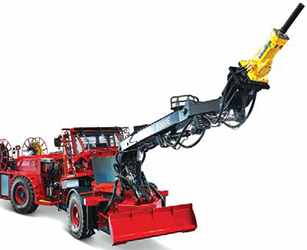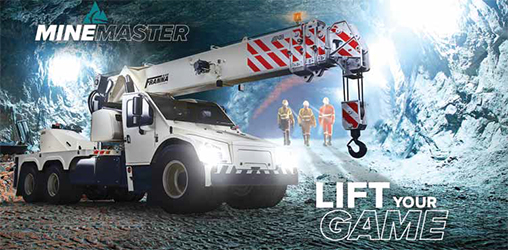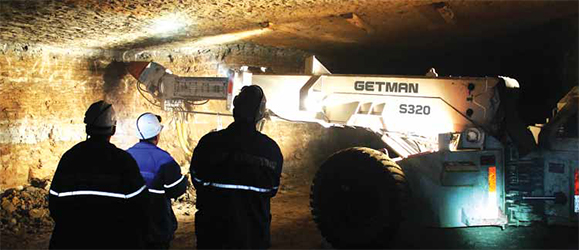
The agile Variomec XS transports materials at the Pyhäsalmi mine in Pyhäjärvi, Finland. XS-series
machines have high payload capacities and four-wheel steering. (Photo: Normet)
New Technology, Regulations Prompt
Innovation
OEMs release machines that meet regulations, feature innovative driveline solutions,
and offer more capabilities and benefits
By Jesse Morton, Technical Writer

Years of Innovation Bear Fruit
A major research and development project
is climaxing at Normet as it incrementally
brings to market more than a dozen new
products in 18 months. In the first half of
2021, Normet launched the XS product
family, which could ultimately span seven
or more machines, and the company
is now prepping to launch the XL line.
Previously, it launched the renewed L-series
product family and the fully electric
M-series SmartDrive product family.
The machines are based on common
platforms, a modular design scheme, and
common parts to streamline maintenance
and service work. They feature basically
the same improved cabin, the same user
interface, the same in-cab screens, and
the same control system.
The new models offer numerous benefits to operators, and have features that give optimal performance and durability, the company said. The XS, M, L and XL lines were featured at Normet Mining Innovation Days, a seminar synchronous to MINExpo. Prototypes from the lines are being, or will be, trialed at Normet’s test mine, the Pyhäsalmi mine in Pyhäjärvi, Finland, near a Normet factory. They are also being trialed at sites around the world as the supplier preps its service staff to support the new models. The R&D project behind the new machines started three years ago. It grew into a major investment, created numerous jobs, and positioned the supplier to rapidly expand its footprint in the coming months and years, Normet said. “That has been quite a project,” said Herkko Juntunen, director, logistics and utility product line. “We’re starting to see the fruit pretty much at the same time. And now there will be intervals between launches.”
The impending launch of the XL line will represent a major milestone for Normet. The machines will be a class size bigger than anything the supplier has previously offered. They will initially be offered with Volvo Penta Stage V engines. “The XL offering consists of two different platforms,” Normet reported at Mining Innovation Days. “HD is a diesel-powered platform with hydrodynamic powerline, and the ED platform is equipped with a Stage V diesel engine and electrodynamic powerline. ED is a brand-new technology in the industry.”
The ED powerline basically made the XL line viable, and prompted Normet to develop niche machines to fill gaps in fleets, Juntunen said. One such machine is a big squatty concrete transportation unit. “The electrodynamic powerline gives us the freedom to place this concrete drum in a very low position and to make a specially shaped drum to give an extremely high carrying capacity in as small as possible dimensions,” he said. That meets a specific trending customer need. “At many of the new places, the tunnels are rather big and they are spraying quite a lot,” Juntunen said. “So there can be several smaller machines or a few big machines that can transport the same amount of concrete.”

The HD machines will have a traditional transmission version designed “for heavy haulage use in material transportation applications,” Juntunen said. The XL machines will offer an upto- 30-metric-ton (mt) payload capacity. They will eventually be offered with the Normet SmartDrive battery-electric architecture, Juntunen said.
Conversely, the XS machines have a 4-mt carrying capacity. At Mining Innovation Days, Normet described the machines in the line as “compact and agile, built with safety and ergonomics in mind.” The XS is made for use in cramped spaces, Juntunen said. It has four-wheel steering, and the turning radius is “extremely tight.” The platform “has a rigid frame and is a very short machine with a fully suspended chassis and the new cabin,” he said. “These machines are FOPS and ROPS approved.”
XS machines have large windows, big mirrors, a forward-angled windshield, the new dashboard and controls. They have a Deutz Tier 3 diesel engine with a hydrostatic transmission. Checks are done from the ground level. “Maintenance is very easy,” Juntunen said. Three applications were announced in May: the XS 040 Material, the XS 035 Crew and the XS 115 Personnel. The loading height on the XS 040 is low. It can be equipped with a 21-kNm crane. It can also come equipped with a pressure washer, a welding generator, compressor or generator. The XS 035 Crew has a crew cabin in addition to the operator cabin. “The operator cabin has room for the operator and two passengers,” Juntunen said. “There is also room for a three-person crew, for a carrying capacity of six people and 3.5 mt of materials.”
The XS Personnel is a bus with an 11-person FOPS and ROPS compartment. “It has a total carrying capacity of the operator plus 13 persons,” he said. It has heating and A/C, suspended seats, and three-point seat belts. “It offers a real nice environment for the passengers,” Juntunen said. Future XS models could include a lube truck, ambulance, personnel lifter or an explosive charging machine. “We also have plans to make a battery- electric version of this carrier,” Juntunen said. “The future of the XS looks promising.”
The new XS machines are designed, in part, in response to newer regulations on equipment around the world. “Traditionally, customers have used Land Cruisers and things like that for smaller transportation needs,” Juntunen said. “Nowadays, because of safety regulations, they like to go with this kind of dedicated mining machine.”
Further, mining machines are simply more rugged and durable underground than are solutions available on the civilian market. “When we have this machine and components designed for underground use, the life will be longer and the operational costs will be much lower,” Juntunen said. The launch of the XS line followed the November 2020 release of new L-Series equipment with Stage V engines. The equipment featured the new cabins and other innovations based on feedback from customers.
The old platform worked but was “outdated so we felt it was time for a change,” Juntunen said. “We collected all the feedback we have got from our customers and used it as guidelines when developing the all-new L-series platform.” The platform can be the base for “logistics, explosives charging machines, lifting and installations or even scaling equipment,” Juntunen said. “This new L-Series has totally new frame structures, with new suspension, and the new electronics and control system.”
One of the foremost benefits offered by the new lines is standardization of parts, which simplifies inventory work and that of maintenance departments. Standardization also contributes to improved safety. “It is easier for the operator to operate different equipment from the offering, as the operator compartment and functions are the same or similar,” Juntunen said.
Those two advantages “bring the best benefits for the customers and also for our staff, so it is easier to service the machines and keep the quality high,” he said. Outside Finland, M-series SmartDrive, new L-series, XS and prototype XL machines are now in mines in Russia, Australia and Chile. Normet has partnered with miners on deployment to track results and to train both the customer’s and company’s service personnel.
“The rollout of all these new machines is quite demanding, quite a big effort on the factory and on the service and front line people,” Juntunen said. “They need to be very well trained and to get familiar with these new machines. That is one reason we are partnering for customer trials, for example, in Australia and Chile, to train our people to get familiar with these machines and the new technologies.”
Grader Developed With AI
MacLean Engineering reported development
of the new GR5 Grader pursued a
company mission to develop and manufacture
fit-for-purpose equipment and
technology. Loosely coinciding with the
release, the mission was coined “Application
Intelligence,” or AI, the company
said in an exclusive report for E&MJ.

For the development of GR5, pursuing AI meant, among other things, pulling from the best features of successful predecessor machines. The grader’s compact design pulls from those of MacLean’s successful line of underground utility equipment. It also borrows heavily from the design of a battery-electric grader the supplier co-developed with Goldcorp to keep underground roads “in tip top shape” to cut maintenance costs and reduce wholebody vibrations, MacLean reported.
It also meant partnering with grader experts from the former Champion-Volvo grader factory in Goderich, Ontario. The result is, to say the least, “a fresh take on the underground grader,” the supplier said. “Leveraging their extensive grader knowledge and MacLean’s mining knowledge, we developed a unit in-house that is designed to move rock and maintain roads in the harsh Canadian Shield,” said Dan Stern, MacLean’s senior product manager for the GR5. “When we designed the GR5 Grader, we started from the ground up,” he said. “We literally started with a clean slate and developed the rig using the latest proven technologies and components.”
For example, the cab was developed using an Oculus Rift VR headset to “map out placement of controls, verify visibility and sightlines, and ultimately get a good sense of what this rig would feel like to operate before any steel was cut,” MacLean said. It features a joystick controller, either an electric powertrain or a diesel engine, and all-wheel drive with traction control using hydrostatics. “The main benefit of the AWD hydrostatic system is to maximize the tractive effort out of the grader to get the most pulling power possible,” Stern said. “This grader can claw itself through the toughest of conditions like a cat on shag carpet.”
The grader is engineered to tear down to fit into shipping crates and hoist cages. Once in the mine, it is capable of maneuvering in the tight confines of underground works to give new and established mines an advanced but practical solution for road and ramp maintenance. “The machine sits about the same height as our utility vehicles and is designed to work optimally in 5-m-by-5-m headings,” MacLean said. It features articulation, and the “advanced hydrostatic drivetrain system monitors steering angles and will speed up the front axle to pull the front end around corners.”
It also features components made to withstand abuse. “The drawbar, circle drive mechanisms and moldboard are all sized for a machine much larger than the GR5,” Stern said. “We know that one of the most abusive environments for a grader is an underground mine. That’s why we sized our application-end components for a machine typically 50% larger than our 20-ton machine.”
The history of AI traces back to the 1990s with the design of the first 900 Series Scissor Bolter. It was further embedded in the corporate lexicon in 2018 when the supplier was tapped to co-develop an electric road grader for Borden. “MacLean took an existing diesel on-surface grader provided by Goldcorp and repowered it using Medatech’s AltDrive technology to create a fully battery-electric road grader,” MacLean said. “The project was a success and resulting grader performed and continues to perform well in its underground mining applications.”
The development “piqued MacLean’s interest in the underground grader market, and enlightened MacLean to the unit’s significance in the mining cycle,” Stern said. The experience helped the supplier pinpoint the “shortcomings of taking an on-surface grader into the underground world,” he said. “Size, visibility, traction, strength, proper speeds, and having robust safety systems were all identified as areas of improvement from the existing offering of graders on the market.” That knowledge was straight-up AI. The term officially became officially emblematic amid the subsequent development of the GR5. “It is the company’s newly minted motto and encompasses how we operate,” Stern said.

World’s First Electric Scaler
Last year, Jama began selling the SBU
8000E, the world’s first fully electric,
battery-powered scaler. Based on a
best-selling platform, the scaler produces
zero emissions, which helps miners
achieve critical sustainable development
goals, the company said.
“It is the No. 1 scaling machine in the
world, and now it even comes with battery
power,” said Eva Skinner, head of business
development, Jama.
The battery solution for the scaler was co-developed by Epiroc. “The customer buys the machine from Jama and the battery is rented by Epiroc,” Skinner said. The battery is certified for global markets, and “is manufactured by Northvolt, which is building one of the world’s largest battery factories in Skellefteå, only a few kilometers from Jama’s own production facility,” she said. The certifications mean, among other things, “it complies with the Low Voltage Directive, the Electromagnetic Compatibility Directive and the Radio Equipment Directive.”
In renting the battery, the customer subscribes “to energy storage capacity, and when the batteries are worn out, they are replaced with newer versions with upgraded technology,” Jama said. The service collects used batteries for recycling at Northvolt, “where the raw material is taken care of and turned into new batteries.” The scaler is module-based and was designed to provide a maximum utilization rate. The machine is 3 m high, 2.7 m wide, with a wheelbase of 4.6 m and clearance of 0.4 m. It has a 5.2-m turning radius, and it weighs 31 mt. It offers a maximum speed of 20 km/h on a level surface.
The unit features a “completely new” driveline that provides the same power that is offered by the predecessor diesel- powered model, Jama said. “The diesel engine with associated components has been replaced by a powerful 160-kW electric motor with control units and is powered by a modular battery solution that is automatically charged with 100- kW charged power during scrapping,” the supplier reported. The scaler offers up to 600 Nm of torque.
New hydraulic valves offer improved reliability over previous models. “In addition, a new mobile control system developed for tough mining environments is presented, which is IP-classified and protected against temperature and vibrations,” Jama said. “The control system has an intuitive user interface.” The boom is designed for heavy scaling. It has a side-tilt function for the hammer. “All joints have expander shafts and plain bushings to manage the force from the hammer,” Jama said. “The hose systems are routed under the boom to protect the hoses,” it reported. “The dimensions and (up to 9-m total) reach are specially adapted for mining.”
The dozer blade “improves accessibility during scaling and protects the machine,” Jama said. The cab was designed to exceed “all existing work environment standards,” the supplier reported. “The floating cab,” which can be titled 13°, “provides minimal low-frequency vibrations and has documented low noise values.” It has air filtration, conditioning and heating. “The operator’s seat is air-suspended, has a three-point belt, double lumbar support, and can be raised and lowered,” Jama said. “A large 15.6-in. color touchscreen provides the best overview of controls and settings for the driver.” Benefits include no emissions, optimal operator comfort, high availability, and the option to operate remotely.

Following that trajectory, the SBU 8000E offers further “poof” that “we are working with product development, and that we are in the front line regarding ‘the next step’ for machinery in the international mining industry,” Skinner said. “This is what the global market is aiming for, a fossilfuel- free mine.”
Customizable Cranes for UG
Franna unveiled the Franna Minemaster
range of pick-and-carry cranes with lift
capacities ranging from 15 mt to 40 mt.
The cranes come fully equipped, ready to
work, and are designed to meet safety requirements,
the company said.
The cranes can be customized, and
can be used in surface and underground
mines, a regional dealer said.
“Indonesian mining companies have been using Franna cranes in coal and hard rock mines to support underground, open pit, workshop, port and blasting operations for many years,” said James Hoyt, director, Berlian Cranserco Indonesia. “Frannas are the most utilized support equipment assets on the mine site.” Benefits include reduced capex, higher utilization and lower costs per mt. The cranes can be set up rapidly for quick deployment. “The compact footprint and unique design of each machine provides unrivaled access to tunnels and other areas of limited space on the mine site,” Franna reported. “From lifting and laying pipes to changing out engines, it is easy to see why Franna cranes are a popular choice for mining contractors.”
Scalers Help With SDGs
Getman Corp. reported it now offers the
S300-series scalers with Cummins B4.5
Stage V and CAT C4.4 Stage V engines.
The engines have low emissions, quieter
operation, and lower fuel consumption,
helping customers meet sustainable development
goals, the company said.
The scalers also feature easy-to-read
CAN-based color displays for quick troubleshooting,
an upgraded transmission
and powertrain, remote transmission filters,
improved ergonomics for operator
comfort, and a quieter cab.

The scalers’ ranges are from 3 m to 9 m. “Rib scaling coverage ranges are from 0 m to 9 m,” Jackson said. “Actual coverage varies depending on the model.” The available boom lengths are 6.1 m, 7.3 m and 9.1 m. “Available accessory tools on select S300-series models include a pick, hammer and rotary cutter,” Jackson said. “The optional push blade helps move fallen debris out of the way while working in the headings.” With a legacy of almost a half century, the scaler series epitomizes the company mission of supplying better equipment and a better service, he said. “We believe we produce the safest, most productive scaler in the industry, and continually pursue design improvements to further enhance customer safety and accessibility.”